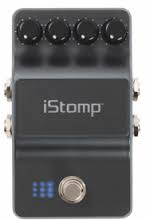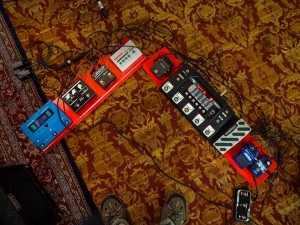
Digitech’s iStomp does a lot of cool stuff for short money (UPDATED)
For the last year or so, I’ve been using an effects pedal from Digitech, the iStomp, in front of my Digitech RP500 running my patch set. I just added another iStomp to my rig, and I reckon it’s time to talk about it.
UPDATE: This post has been edited to reflect the fact that Digitech has updated the iStomp app to work with iOS 11. Yippee!
Not just a dedicated FX pedal
The iStomp is an unusual pedal in that it has no dedicated FX in it. Basically, the iStomp is a digital device that will load any effect that Digitech supplies for it (and the company supplies dozens of FX, mostly free for the download, about which more in a moment). So it can be a distortion pedal, a chorus, a reverb, a delay, a rotary speaker, an auto-filter, and lots of other things–just not all at once.

The iStomp has been discontinued recently by Digitech, but you can easily find them used in good to great condition in the neighborhood of $50 on eBay and from used instrument dealers like Guitarcenter.com. Digitech still offers 47 effects for the iStomp via download, and the Stomp Shop app that you use to do that is still available for (free) download from Digitech’s site and from Apple’s app store.
A caveat is that the Stomp Shop cable supplied by Digitech for connection between the iStomp and your iOS device is an older design; it works fine with my iPad2 (which I’m keeping around just to use with the iStomp), and with my old iPhone 4, but not with my iPhone 5. (An adapter for the old-style cable to iPhone 5 and later is available from Apple, and that’s the only one Digitech recommends. I’ve tried an alternative brand, and it didn’t work very well.) Finally, the iStomp runs on wall power, not batteries, so you need to make room for it in your electrical setup.
Caveats Aside, It’s a Lot of FX for Short Money
In effect, Digitech has taken the FX it put into the RP series devices and broken them out one by one, so a player who’s more comfortable with a traditional stompbox setup–i.e. with a device that you can control in real time using fingers on dials instead of a computer interface–can pick and choose among those FX and produce a stompbox that’s dedicated to one and only one. But unlike a regular stompbox, you can load a different effect into the iStomp any time you choose. You don’t need to be a computer wiz to load an effect; if you’re comfortable setting up and using apps on your iPhone or iPad, you know how to use the iStomp.
The list of FX on offer are–with one exception–free to download and use in your iStomp. You can see the full list here. There’s plenty of stuff on that list that a harmonica player can use. That includes two reverbs–a Lexicon hall and a spring–a few delays, an overdrive or two, a rotary speaker, two multi-timbral pitch shifters (one modeled on the Boss Octaver), plenty of choruses and flangers, tremolos, vibratos, the FX25 envelope filter, and more. I just love that FX25 envelope filter model; it’s very easy to set up distinctive auto-wah sounds on it that respond easily to breath pressure, but don’t cross the line into feedback territory. The iStomp has four rotary dials for changing sounds in real time; some of the FX use all of the dials, some use only two or three, depending on the nature of the effect (and how the original hardware the effect is modeled on is set up). The only other control is a footswitch for turning the effect on and off. (If you want a footpedal for controlling FX in real time like the ones on the Digitech RPs, get an RP.)
Good Standalone, Good in Front of Your Digitech RP
At current used prices the iStomp is probably the least expensive choice out there for a high quality standalone reverb or delay floor pedal, and the modulation and pitch FX sound great too. (The multi-timbral Swing Shift pitch shifter doesn’t have all the flexibility of an Electro Harmonix POG or HOG, but it sounds good and costs a few hundred dollars less.) Running one or two in front of your Digitech RP allows you to get past the RP’s one-modulation-effect-per-patch limitation without taking up a whole lot of space at your feet. The device has practically zero self-generated noise to my ears, so dropping it into an FX chain doesn’t add the wrong kind of dirt to your sound.
Right now I’m running two iStomps with my rig; one loaded with the Swing Shift multi-timbral pitch shifter at the front of my FX chain, followed by the FX25 envelope filter (autowah), then the RP500. (I don’t care to load either of those iStomps with a reverb or delay, because the RP500 has a very nice selection of both already.) With this setup I can produce some very big sounds indeed. (And when you add the Zoom G3 into the picture via a parallel chain, hoo boy.)

If you’ve already got a traditional harp rig–a bullet-ish or vocal mic into a tube amp–one of the reverbs or delays might be the best first choice for the iStomp, especially if you don’t already have a decent version of either of those FX. The next in line for a traditional rig might be the rotary speaker effect, which can help a harp player produce very convincing Hammond organ-type tones. (Add another iStomp running the Swingshift multi-timbral pitch shifter in front of the rotary speaker effect and the organ sounds get even more convincing.) For players who already use a battery of FX, or (like me) one or two multiFX devices in their chains, you can take your pick.
This technology obviously didn’t have the market effect that Digitech was hoping for, or by now we’d have the iStomp 2 or 3 instead of it being discontinued. But there’s plenty of them around, they’re inexpensive, and they work completely as advertised. I’m keeping mine.
Tags In
Related Posts
3 Comments
Leave a Reply
You must be logged in to post a comment.
WHAT’S NEW
Categories
- Audio/Video
- Blog
- Blue Future
- Digitech RP Tricks and Tips
- Discography, CDs, Projects, Info, Notes
- Featured Video
- For the Beginner
- Gallery
- Hunter's Effects
- Hunter's Music
- Huntersounds for Fender Mustang
- Meet the Pros
- More Video
- MPH: Maw/Preston/Hunter
- My Three Big Contributions
- Player's Resources
- Pro Tips & Techniques
- Recommended Artists & Recordings
- Recommended Gear
- Recorded Performances
- Reviews, Interviews, Testimonials
- The Lucky One
- Uncategorized
- Upcoming Performances
- Zoom G3 Tips and Tricks

[…] while ago we wrote about Digitech’s iStomp, a pedal that can be loaded with any of dozens of very nice FX via Digitech’s Stomp Shop app. […]
“The list of FX on offer are–with one exception–free to download” .. What is the 1 exception that’s not free, and how much is it?
It’s an effect designed by Adrian Belew called the “Impossible Effect”. Last I saw it was selling for $19. I haven’t tried it.